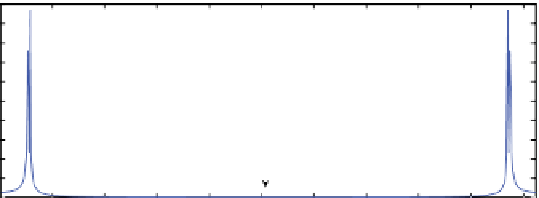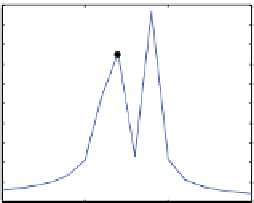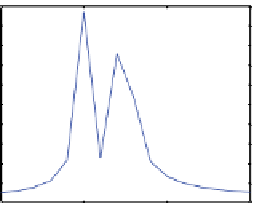Geology Reference
In-Depth Information
(a)
2
N=512
Δ
t=1
1
0
-1
-2
0
50 00
150
200
250
n
300
350
400
450
500
(b)
500
400
Positive
frequencies
f=[0, f
nyq
]
Negative
frequencies
f=[-f
nyq,
-
Δ
f]
300
N/2=256
200
100
0
0
50 00
150
200
250
300
350
400
450
500
n
(c)
(d)
500
0.050
0.055
-0.055
-0.050
400
300
200
100
0
20
25
30
35
480
485
490
495
n
n
Figure 4.8
(a) Real-valued digital time series of length N = 512 with two frequencies, 0.05 and 0.055, y
n
= sin(2πnΔt0.050)+
sin(2πnΔt0.055), n=1,2,…,N and Δt=1. (b) FFT squared modulus of y
n
(complex conjugate of the Fourier
coefficients, which determines the power), with Δf = 1/(NΔt) = 1/512, showing two closely spaced frequencies: 0.050
at n = 26.6, and 0.055 and n = 29.16 in the positive frequencies and -0.050 at n = 487.4 and -0.055 at n = 484.84 in the
negative frequencies. (c) Close-up of the two positive frequencies. (d) Close-up of the two negative frequencies. The
true frequencies (0.050 and 0.055; dashed red lines) do not coincide with the sampled frequencies (black dots) and
do not recover the true squared modulus (i.e., true value of 512) of either of the frequencies.
length of the series, and the highest measurable frequency, 1/2(Δt) = f
nyq
, is
the Nyquist frequency. The FFT stores the “Fourier coefficients” of the sines
and cosines as a complex variable that is a function of frequency with a spac-
ing, called the Rayleigh spacing, of Δf = 1/NΔt, for sampled frequencies
f
n
= (n - 1)Δf, n = 1, …, N. In practice, this FFT “mesh” resolves frequencies
from 0 to f
nyquist
= 1/(2Δt), which is up to n = N/2+1 (for even N) and up to
(N + 1)/2 (for odd N).



































